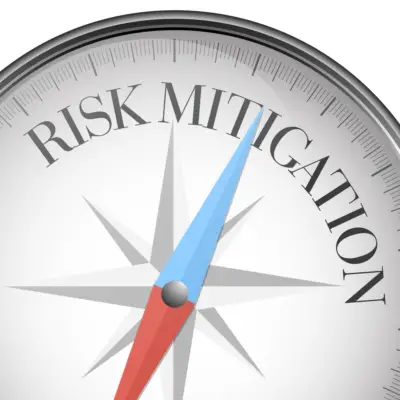When assessing risk, it’s important to ask a series of pertinent questions to ensure a comprehensive understanding. Some key questions to consider include:
- Do you treat risk reactively rather than proactively? (source: Our Insights)
- How would you evaluate or describe the tone at the top of the organization? (source: LexisNexis)
- What is the type of issue that you are assessing? (source: Aviation Safety Blog)
- Is there a process in place for identifying, collecting information about, and providing timely alerts for emerging or changing risks? (source: BDO USA)
- Does our hedging strategy make sense in the current market environment? (source: ION Group)
- What are our most important assets? (source: Edafio)
- Are you managing risk fast enough, so you can act when necessary? (source: Norman Marks)
These questions cover various aspects of risk assessment, from proactive management to specific evaluation criteria, and can provide valuable insights into an organization’s risk landscape.

When considering risk, ask about the nature of uncertainties and their implications on operations. Inquire about the likelihood and consequences of potential risks. Explore triggers that may escalate risks and ways to mitigate them effectively.
Evaluate strategies like avoidance, transfer, reduction, or acceptance. Understand the importance of communicating risks clearly to stakeholders. By posing insightful questions about risk, you can gain a deeper understanding of how to manage uncertainties in decision-making processes.
Key Takeaways
- What are the potential risks and their impact on objectives?
- How likely are the risks to occur, and what is their severity?
- Are there existing controls in place to manage identified risks?
- How will the organization respond to high-risk events?
- How can stakeholders contribute to risk management decisions?
Understanding the Nature of Risk
Risk assessment methods, risk tolerance levels, and risk mitigation strategies are essential components in understanding the nature of risk.
By utilizing various assessment tools, organizations can identify and evaluate potential risks to their operations.
Establishing clear risk tolerance levels and implementing effective mitigation strategies are key steps in managing and reducing the impact of these risks.
Risk Assessment Methods
When evaluating potential risks, it is essential to utilize systematic methods that enable a thorough understanding of the nature and scope of the risks involved.
Risk assessment methods serve as structured approaches to identify, analyze, and evaluate potential risks to a project, business, or any other endeavor.
These methods often involve processes such as risk identification, risk analysis, risk evaluation, and risk treatment.
Common risk assessment techniques include brainstorming sessions, checklists, interviews, and SWOT analysis.
Quantitative methods like Monte Carlo simulation and decision tree analysis are also utilized for a more numerical evaluation of risks.
Risk Tolerance Levels
Understanding the nature of risk involves carefully evaluating an organization’s tolerance levels towards potential threats and uncertainties.
Risk tolerance refers to the degree of risk exposure an organization is willing to accept in pursuit of its objectives.
It is essential to establish clear risk tolerance levels to guide decision-making processes and risk management strategies effectively.
Factors influencing risk tolerance include the organization’s goals, industry regulations, financial position, and stakeholder expectations.
Risk Mitigation Strategies
Mitigating risks effectively requires a thorough understanding of the potential threats and uncertainties an organization may face.
Risk mitigation strategies are proactive measures taken to reduce the likelihood or impact of risks on a business. These strategies involve identifying, evaluating, and prioritizing risks before implementing appropriate actions to address them.
Common risk mitigation techniques include risk avoidance, risk transfer, risk reduction, and risk acceptance.
Risk avoidance entails steering clear of activities that could lead to potential risks, while risk transfer involves shifting the risk to another party, such as through insurance.
Risk reduction focuses on implementing controls and safeguards to minimize the impact of risks, and risk acceptance involves acknowledging the risk and preparing to deal with its consequences if it occurs.
Effective risk mitigation strategies are essential for safeguarding a company’s operations and enhancing its resilience in the face of uncertainties.
Assessing Probability and Impact
When evaluating risk, it is essential to take into account both the probability of an event occurring and the potential impact it could have.
By analyzing the likelihood of various outcomes and the severity of their consequences, organizations can prioritize their risk management efforts effectively.
Employing risk assessment techniques allows businesses to make informed decisions to mitigate potential threats and capitalize on opportunities.
Probability Vs Impact
Evaluating the probability and impact is a critical component of effectively managing risk in any organization. Probability refers to the likelihood of a risk event occurring, while impact signifies the consequences if it does happen.
By appraising these factors, organizations can prioritize risks based on their potential severity and likelihood. This evaluation allows for the allocation of resources towards mitigating or addressing the most critical risks first.
Understanding the balance between probability and impact enables decision-makers to make informed choices about risk response strategies. By focusing on risks with a high probability and significant impact, organizations can enhance their resilience and minimize potential negative outcomes.
Probability and impact analysis form the foundation for robust risk management practices in today’s dynamic business environment.
Risk Assessment Techniques
Utilizing effective risk evaluation techniques is essential for accurately gauging the probability and impact of potential risks within an organization. By appraising the likelihood of a risk occurring and the severity of its consequences, businesses can prioritize and address the most critical threats.
One common method is the qualitative approach, which involves subjective judgments based on expert opinions and historical data.
Quantitative techniques, on the other hand, rely on numerical analysis to assign specific values to the probabilities and impacts of risks. Tools like risk matrices, decision trees, and Monte Carlo simulations aid in this process.
Through a systematic evaluation of risks, organizations can make informed decisions to mitigate vulnerabilities and enhance their resilience in the face of uncertainties.

Identifying Risk Triggers
Identifying risk triggers is an essential aspect of risk management.
By understanding the risk assessment methods and mitigation strategies, organizations can proactively address potential issues before they escalate.
Recognizing these triggers allows for the implementation of effective risk responses to protect the project or business from adverse consequences.
Risk Assessment Methods
One pivotal aspect of effective risk evaluation involves pinpointing the specific factors that can act as triggers for potential risks.
When it comes to identifying risk triggers, various methods can be utilized to evaluate and categorize potential threats.
Here are four key risk evaluation methods:
- Historical Data Analysis: Examining past incidents to identify trends and patterns that could indicate future risks.
- Brainstorming Sessions: Engaging stakeholders to gather diverse perspectives and insights on possible risk triggers.
- SWOT Analysis: Evaluating strengths, weaknesses, opportunities, and threats to identify internal and external factors that may lead to risks.
- Scenario Planning: Developing hypothetical scenarios to evaluate different risk outcomes and their likelihood.
Mitigation Strategies
In the domain of risk management, a critical focus lies on proactively addressing potential threats through strategic mitigation strategies.
Mitigation strategies are structured plans designed to reduce the impact of risks on a project or organization.
These strategies involve identifying risk triggers, which are early warning signs that indicate a potential risk event.
By recognizing these triggers, organizations can implement proactive measures to prevent risks from materializing or minimize their negative consequences. Effective risk trigger identification allows for timely interventions, ensuring that risks are managed efficiently.
Common mitigation strategies include risk avoidance, risk transfer, risk reduction, and risk acceptance.
Through the systematic application of mitigation strategies, organizations can enhance their resilience and protect their interests against unforeseen risks.
Evaluating Risk Mitigation Strategies
When evaluating risk mitigation strategies, it is essential to take into account the effectiveness of various risk assessment tools.
Additionally, contingency planning techniques play a significant role in mitigating potential risks.
Risk Assessment Tools
Utilizing specialized risk assessment tools is crucial for organizations aiming to effectively evaluate and implement risk mitigation strategies.
These tools provide a structured approach to identifying, analyzing, and prioritizing risks, enabling businesses to make informed decisions to safeguard their operations.
When selecting risk assessment tools, consider the following:
- Comprehensive Coverage: Guarantee the tool covers a wide range of risks pertinent to your industry and organization.
- Scalability: Choose tools that can adapt to the size and complexity of your business.
- Integration Capabilities: Opt for tools that can seamlessly integrate with existing systems for efficient risk management.
- User-Friendly Interface: Select tools that are intuitive and easy to use, facilitating widespread adoption among employees.
Contingency Planning Techniques
Effective evaluation of risk mitigation strategies through contingency planning techniques is essential for organizations to proactively address potential threats to their operations.
Contingency planning involves identifying potential risks, developing response plans, and establishing clear communication channels.
By considering various scenarios and their impact on business continuity, organizations can better prepare for unexpected events.
Techniques such as risk prioritization, scenario analysis, and resource allocation play important roles in effective contingency planning.
Regular testing and updating of contingency plans are also crucial to guarantee their relevance and effectiveness.
By incorporating these techniques into their risk management practices, organizations can enhance their resilience and minimize the impact of unforeseen events on their operations.

Communicating Risk to Stakeholders
To effectively manage risks in a project, clear and concise communication with stakeholders regarding potential risks is vital.
When it comes to communicating risk to stakeholders, there are several key points to take into account:
- Tailor the message to the audience’s level of understanding.
- Use visual aids such as graphs or charts to illustrate complex risks.
- Provide regular updates on risk assessment and mitigation efforts.
- Encourage open dialogue and feedback to make certain all concerns are addressed promptly.
Frequently Asked Questions
How Do External Factors Influence Risk Assessment?
External factors play an important role in risk assessment by shaping the landscape within which risks unfold.
Understanding how these factors, such as economic conditions or regulatory changes, impact the assessment process is essential for thorough risk management strategies.
What Role Does Historical Data Play in Risk Identification?
Historical data is essential in risk identification as it provides insights into past occurrences and trends.
By analyzing historical data, organizations can better understand patterns, anticipate potential risks, and make informed decisions to mitigate future uncertainties effectively.
Can Cultural Differences Affect Risk Perception?
Cultural differences can greatly influence risk perception. Varied values, beliefs, and norms can shape how individuals interpret and respond to risks.
Understanding these differences is essential in effectively evaluating and managing risks in diverse environments.
How Do Industry Regulations Impact Risk Management?
Industry regulations play an important role in shaping risk management practices.
Compliance requirements, standards, and guidelines set by regulatory bodies have a substantial impact on how organizations identify, assess, mitigate, and monitor risks within their operations, ensuring adherence to legal obligations.
What Are Common Challenges in Stakeholder Risk Communication?
Common challenges in stakeholder risk communication include balancing transparency with confidentiality, addressing varying levels of risk literacy, managing conflicting stakeholder interests, ensuring timely and accurate information dissemination, and fostering trust and credibility through effective communication strategies.
Conclusion
In summary, asking important questions about risk involves understanding its nature, evaluating probability and impact, identifying triggers, evaluating mitigation strategies, and effectively communicating with stakeholders.
By following these steps, individuals and organizations can better manage and navigate potential risks, leading to more informed decision-making and improved outcomes.

It is vital to approach risk with a systematic and thorough mindset to guarantee preparedness and resilience in the face of uncertainties.

Chris Ekai is a Risk Management expert with over 10 years of experience in the field. He has a Master’s(MSc) degree in Risk Management from University of Portsmouth and is a CPA and Finance professional. He currently works as a Content Manager at Risk Publishing, writing about Enterprise Risk Management, Business Continuity Management and Project Management.


